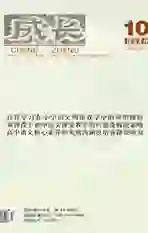中学英语中的正反译法
2017-10-15谢紫薇
【摘 要】通过分析句子和短语翻译的“逆转”翻译,本文探讨了中学英语中可能出现的使用正反译法的类型及其定义。
【关键词】正反翻译法;类型
翻译是一种将信息从一种(源语言)转移到另一种语言(目标语言)的活动。英语的实用性在中学英语学习中越来越重要,翻译在重要考试中的比例也逐步提高,每种语言都有自己的表达方式。有时,当我们很难找到一种表达相同意思的确切方法时,我们必须用另一种方式表达,让需译的内容更流畅,更符合目标语言读者的语言习惯。翻译有很多方法,本文主要讨论的是将在源语言为肯定形式翻译后转换成否定形式(反之亦然)的翻译技巧。本文中,它被称为正反译法。本文总结了中学英语学习中可能采用的正反译法的类型,以便更准确地翻译。此方法适应的范围非常大,本文将其分为两类。一种是将源语言中的肯定形式转换为否定形式,另一种是将源语言否定形式转换为目标语言中的肯定形式。本文着重讨论前者。
一般来说,可以用词性和句法功能来进行分类。
A)动词及短语
ignore,exceed, end, wonder, keep , protect, idle away , and so on.例:
1)Keep off the grass. 不要践踏草坪。
2)He refused to take the money. 他不愿意接受那笔钱。
3)On Sunday I idle away my time. 星期天我無所事事。
4)A trip to Mount Huang ends your interest in other mountains. 黄山归来不看岳。
5)The evidence is conclusive, excluding all the possibility of doubt. 证据是确凿的,不容怀疑。
B) 名词:
absence,failure,exclusion,stranger,omission and so on.例:
1) Shortness of time has required the omission of Prof. Smith.由于时间短促,没能拜访史密斯教授。2)He is a total stranger to me. 我完全不认识他。
3)He concentrated all his attention on one or tow problem to the exclusion of others.
他把全部注意力集中在一两个问题上而不顾其他问题
C) 形容词及短语:
few, little, free from, far from, short(of),be worthy of, important, least… 例:
1)His design is far from being satisfactory. 他的设计根本不能令人满意。
2)He is the last man to do such thongs. 他绝不会做这样的事。
3)Young people are the least conservative. 年轻人最不保守。
4)This distinction between schooling and education implied by this remark is important. 这种观点所暗示的学校教育与教育之间的区别不容忽视。
5) It is truly worthy of the name of “the bridge of the word”
它无愧于“世界桥梁”的称誉。
D)副词及短语:
little, otherwise, too…to, fully, absently, exactly and so on
1)Exactly ! 一点不错!
2)I little knew what trouble he was going to have.
我根本不知道他会遇到什么麻烦。
E)连词:
before, unless, or, (rather) than, more than,…
1)Ill do it now before I forget. 趁还没忘,我现在就来做这件事。
2)I rather than you should do the work. 该做这件事的是我,而不是你。
3)He had to have a job or go hungry. 他得有份工作,不然就得挨饿。
4)I am wiser than to believe that. 我不至于蠢到会相信这件事。
5Some of the stories were really more than could be believed.有些故事实在不能令人相信。
F)介词及短语:
without, except, beyond, instead of, beneath, in place of but for etc.
1)As a scholar , he is beneath Henry. 作为一个学者,他还不如亨利。
2)Einsteins theory of relativity is quite beyond. 我一点也不懂爱因斯坦的相对论。
3)What you have said is quite beside the point 你說的与正题完全不相关。
i.谓语:
1.When he turned to look at his suitcase, it disappeared. 这个句子的谓语的本义是“消失”,如果我们这样翻译:“他转过脸看他的手提箱时,它消失了。”语气较弱,所以翻译成“不翼而飞”,这个表达更地道、简洁。
2.The secret of air travel escaped the genius of the worlds greatest scholars for thousands of years. 译文“几千年来世界上最伟大的科学家都未能注意到空中飞行的奥秘”比“空中飞行的奥秘逃掉了几千年来世界上最伟大的学者的智慧”更为流畅。
ii.定语:
1. It was a probably cheap baby.
如果定语翻译成“便宜”,不就符合语言习惯。我们使用“不值钱的”相对更好。还有一个类似的例子:2. He slept a troubled dreamy sleep last night. 他昨晚极不安睡。
iii.状语: 副词、介词短语和分词短语常被用作英语句子的状语。在某些句子中,它们的形式或意义不是否定的,但仍然需要被翻译成否定,例如:1. Carl had been looking steadily at the skinny house. “Steadily”不是否定的形式或意义,如用正反译法译成“目不转睛”就能够更生动。2. Gitano looked questioningly at Judy这句话的副词显然是肯定的。如果我们把它译成“带有疑问地”,意思也可以表达清楚,但似乎较冗长。所以更好的应该是“”不解地看着”。如果我们这样翻译,风格将会不同。
总之,翻译不是一个简单的过程,它需要译者对源语言和目标语言都要有良好掌握的复杂过程,准确的译文应该适应目标语言的规则。中学生是未来的语言传播和使用者,在中学掌握重要的翻译方法会给未来的活动打好基础,正反译法的正确使用是能帮助他们更好的掌握语言的不同,从而为将来可出现卓越的翻译版本创造更多可能。
作者简介:谢紫薇(1981-),女,湖南衡阳,湖南省衡阳市第十九中学,本科学历,中学一级英语教师,主要从事初中英语教育研究。
